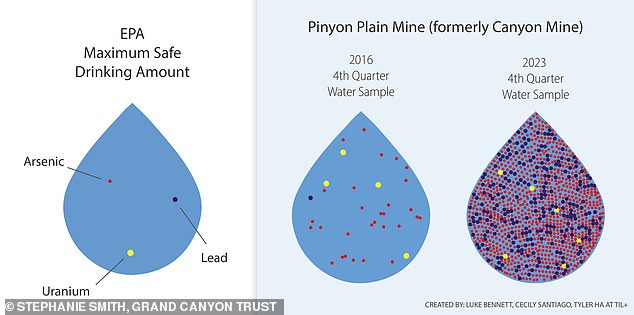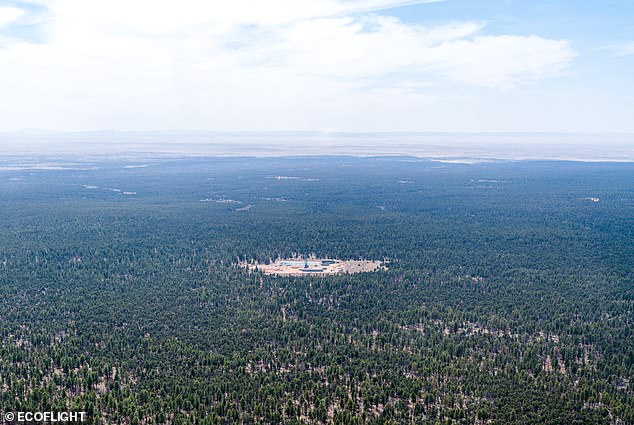A uranium mine has dumped nine million gallons of toxic water out of the shaft near Arizona‘s Grand Canyon since opening last year, a new study has revealed.
Pinyon Plain Mine, located 10 miles from the park, claimed its project would not contaminate the pristine landscape when it began operations in December 2023.
But a new investigation revealed Monday found high levels of uranium, arsenic and lead in an evaporation pond six miles from a Grand Canyon at the site that feeds into others – potentially contaminating local drinking water used by thousands.
Grand Canyon Trust, a non-profit dedicated to safeguarding the park, discovered lead levels were 812 times the US Environmental Protection Agency (EPA) limit, arsenic levels were 243 times the limit and uranium levels were six times the limit.
However, Pinyon Plain Mine has pumped 66 million gallons of toxic water the pond since 2016.

Environmentalists argue that uranium mining contaminates groundwater and pollutes the air

Energy Fuels, the mine’s owner, claimed there isn’t drinking water for the mine to impact, the report found that the mine’s contaminated floodwater can seep from one aquifer to another, ultimately polluting the local drinking water.
When Energy Fuels proposed the mine, ‘at first, they promised they wouldn’t strike groundwater,’ Amber Reimondo, the energy director for Grand Canyon Trust told DailyMail.com.
‘That evolved over time, and they said maybe they’d hit a little bit of water.
‘Then they said a drill test showed that layers of the mine were going to be saturated with water.
‘But we’ve never seen them acknowledge that the story changed.’
Energy Fuels had pitched the project in 1986 as being a dry mine, which manually removes ore from the site and extracts uranium at a nearby conventional mill.
A environmental report submitted by the mining company that year claimed: ‘The possibility of significant ground water contamination from the mine is remote.
‘Ground water flows, if they exist, are likely to be at least 1,000 feet below the lower extremities of the mine.
‘This, plus the low potential for encountering groundwater in the mine, effectively eliminates the possibility of contaminating the Redwall-Muav aquifer.’
Uranium is a naturally occurring radioactive element that has been mined and used for its chemical properties for over a thousand years.
The US was the world’s leading producer from 1953 to 1980 when the government offered incentives for discovering on American soil.
It is now primarily used as fuel for nuclear reactors that make electricity, but how the process is done can pose health and ecological hazards.
Since 2016, the mining company has toxic water has been continuously pumped out of the mine shaft that contains dangerous levels of arsenic, lead and uranium that far exceeds levels considered safe for drinking.
Curtis Moore, SVP of Marketing and Corporate Development at Energy Fuels told DailyMail.com: ‘The water referenced in this report is part of normal mining operations and is not cause for concern.
‘It is contained within the mine site and is safely stored in a lined impoundment. It poses no threat to ground water or drinking water.
‘These systems are subject to strict regulatory oversight and are in place to capture and store water that is encountered during normal mining operations. ‘
Grand Canyon Trust’s report found that the uranium in the mine’s water increased by 150 percent in 2023, but the major jump was arsenic which increased by 4,700 percent since 2022 and lead rose by 8,100 percent.
The EPA’s screening limit for lead is 200 parts per million, uranium is 30 micrograms per liter and the maximum arsenic contaminant level is 10 parts per billion.
Although the mine sits roughly six miles from the Redwall-Muav Aquifer, which supplies drinking water to locals, the faults and fractures in the rock allow the contaminated water to trickle down from the upper Kaibab and Coconino Aquifers to the natural spring.
‘What this demonstrates is that this whole time, they’re exposing uranium ore to water and increasing the likelihood that contaminated water finds its way out of the mine because you’re increasing the amount of contaminants in the water,’ Reimondo said.

Grand Canyon Trust reported that Pinyon Plain Mine’s water contained uranium that was six times the maximum contaminant level considered safe for drinking – while lead was 243 times the allowed amount and arsenic was 812 times the limit

The Canyon Plain Mine opened in December and extends across 17 acres
Energy Fuels, which owns the mine, previously told DailyMail.com that ‘there is no ‘radioactive waste’ from uranium mining at the mine, nor is there any drinking water to impact.’
However, ‘According to a recent interview with scientist Dr. Laura Crossey, there are so many faults and fractures in the rock in the region that it’s just not realistic to say water can’t migrate downward,’ a Grand Canyon Trust spokesperson told DailyMail.com.
‘The importance of the faults is that they provide a vertical pathway for water to move to seek a lower level because ultimately, water is searching for sea level,’ Crossey, a professor of earth and planetary sciences at the University of New Mexico, said in an interview on Monday.
Energy Fuels senior associate Sam Stookesberry has claimed the reports are nothing more than ‘fear-mongering’ and a ‘coordinated scare campaign being waged by activists.’
However, after studying the natural tracers of the rock, Crossey found that ‘there is a risk of downward migration through faults’ within less than 10 years.

The Grand Canyon hosts 1.3 percent of the U.S.’ uranium reserves
‘The more mineralized rock that is exposed during mining operations, the greater long-term risk emerges that contaminated groundwater could find its way into surrounding aquifers, especially when the mine closes and the company is no longer present to manage the inflow of water,’ Reimondo said.
‘The mine is depleting precious groundwater and the risks to vital water sources, especially for the Havasupai Tribe, are poorly understood. This is the wrong place for a uranium mine,’ she added.
The company has previously denied accusations that the mine will contaminate springs, calling them ‘unscientific’ and claiming people should not be concerned about the effect the mine will have on the environment.
‘There is no ‘radioactive waste’ from uranium mining at the mine, nor is there any drinking water to impact,’ spokesperson Curtis Moore claimed in January.
‘Despite the unscientific claims of the anti-nuclear NGOs, there is truly nothing to be concerned about from this small, low-impact mine,’ he added.
Reimondo warned that ‘the biggest risk is when the mine stops operating’ the groundwater will still be exposed to the dangerous minerals inside the abandoned mine space.
‘[Energy Fuels] will say they’ll plug off the groundwater that flows into the hole, but that’s impossible,’ she continued, clarifying that water will always find a way to seep into the faults and fissures in the surrounding rocks.
‘When that happens, they won’t be there anymore to actively pump groundwater out, so the water will flow through the exposed rock and become more contaminated over time.’
Even if the Pinyon Plain Mine closed tomorrow, the contaminated mine water is already a perpetual problem, according to the Grand Canyon Trust.
‘It would be impossible to clean up the aquifers if they became contaminated,’ Reimondo said. ‘You have to know what you’re dealing with and be able to control the environment.
‘But you can’t do that if you don’t know where the groundwater is flowing to.’
The only solution is to perpetually pump the groundwater out of the mine and into the evaporation pond which is ‘a huge waste of valuable groundwater and immensely costly,’ she said.

The mine sits on 17 acres of land and has distributed 66 million gallons of contaminated water since 2016

The Havasupai Tribe protested against the Pinyon Plain Mine, saying it would contaminate local drinking water and harm their religious sites
The Havasupai Tribe had repeatedly tried to prevent the mine from opening, arguing that it would contaminate local groundwater and threaten cultural and spiritual religious sites.
‘Our tribal community’s only source of water is fed by aquifers, which unfortunately sit directly below the Pinyon Plain Mine,’ the Havasupai Tribe told DailyMail.com in January.
‘The Arizona Department of Environmental Quality and the federal EPA claim there is no danger to us, that no harmful effects will come our way from this alleged ‘clean energy’ source,’ the tribe continued.
‘But how can they so confidently make such a claim when Energy Fuels has already contaminated one of the two aquifers while digging the mine shaft?’
‘I don’t think that a reasonable response is to say, ‘let’s wait and see,’ Crossey said, ‘because cleaning up an aquifer that’s kilometers deep in the earth is simply not going to happen. It’s a one-way street.’












